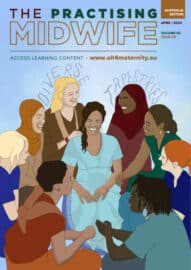Finally! The 2019 MBRRACE Report is published
Hannah Tizard – Research Midwife, Editor-in-Chief Student Midwife Journal and Founder BloodtoBaby.com
Surveillance data on women who died during or up to one year after pregnancy between 2015 and 2017 in the UK
Most maternity professionals will know that the 2019 Mothers and Babies Reducing Risk through Audit and Confidential Enquiries (MBRRACE) Report1 was embargoed under ‘electoral purdah’ during the December 2019 general election campaign.
Purdah prevents the civil service (central and local government) from making announcements about any new or controversial government initiatives that could be seen to be advantageous to any candidates or parties in forthcoming elections.2 The ‘curtaining’ or ‘veiling’ of news under purdah designed to relieve any potential to sway votes.
Surprisingly, purdah does not apply to candidates for political office, who are free to espouse any information they wish in order to gain support from the electoral population! This opening up a whole new topic of media bias, factual accuracy and sensationalised storytelling, for discussion at another time!
Controversially, purdah is being increasingly enforced on the National Health Service (NHS), despite NHS bodies not being regarded as civil service. In 2017, an NHS publication of financial deficits of NHS trusts across England was embargoed under the same rule.3 Today in 2019, we have seen the MBRRACE report being withheld, so now purdah is arguably being used to suppress bad news — for political gain, in so doing preventing hard-working NHS staff, service providers and policymakers from instigating required change to safeguard the maternity population.
So, what does the MBRRACE report deliver?
The report emphasises that the United Kingdom fares better than other countries with regard to safety in childbirth. Indeed, the MBRRACE report, seen as a gold standard instrument guides our knowledge and understanding, also helping to identify topics for future inquiry and research.
“There was a statistically non-significant decrease in the overall maternal death rate in the UK between 2012-14 and 2015-17, which suggests that continued focus on implementation of the recommendations of these reports is needed to achieve a reduction in maternal deaths.”
The report highlights this being predominantly due to a decrease in maternal deaths from haemorrhage and amniotic fluid embolism. Whilst this is good news and demonstrates improvements in the management of care for postpartum haemorrhage identified in the 2014, 2017 and 2018 reports. However, building on messages conveyed in previous annual MBRRACE reports there are worrying trends emerging.
 Inequality
Inequality
The infographic makes it very clear that maternal deaths are not evenly spread across the population demographic, with black and minority ethnic groups (BAME) being the worst affected. Asian and black women only make up 14% of women giving birth but yet make up 34% of women that die. Black women make up 4% of the birthing population but 18% of women that die. These statistics are truly shocking.
In addition, women from the most deprived areas of the country and more than twice as likely to die as those in the least deprived areas. The report details that 20% of women who died were known to social services, highlighting further the vulnerability of many women who died.
Lucia Rocca-Ihenacho rightly declares
“This report only confirms that social inequality is at the heart of many negative outcomes.”
Given the alarming inequity reported and an overall tendency suggesting that the inequality gap is increasing, we could surmise that this contributed to the purdah placed on this report. It demonstrates a lack of prioritisation, investment and funding from the government, not only into the NHS but also to support widespread poverty, education and lifestyle issues, lack of mental health and drug and alcohol support services.
Key themes
Cardiovascular disease remains the leading cause of women’s deaths during or after pregnancy in the UK and Ireland. This is followed by thrombosis and thromboembolism. Maternal suicide is only the fifth most common cause of women’s deaths during pregnancy and immediately afterwards but is the leading cause of death over the first year after pregnancy.
The report details information and action points for:
- Care of women with cardiovascular disease
- Care of women with pre-eclampsia and related hypertensive disorders of pregnancy
- Care of women with early pregnancy disorders
- Prevention and management of accidents in pregnancy or postpartum
- Messages for Maternal Critical Care
Primary message
“Assessors judged that 44% of women who died had good care. However, improvements in care which may have made a difference to the outcome were identified for 29% of women who died”
Fundamentally, with the increasingly complex medical and social factors involved in the lives and care of the women most vulnerable in society, the report signals to imperative focus on improving ‘joined up care’ or multidisciplinary working. Not only directly in clinical practice but by pulling together of recommendations laid out by strategy and policy makers, such as The NHS Long Term Plan’,4 National Institute of Health and Care Excellence (NICE), European Society of Cardiology guidelines,5 The Joint Royal Colleges Ambulance Liaison Committee (JRCALC), Action on Pre-eclampsia (APEC), Provision of Anaesthesia Services for an Obstetric Population 2019.6
This ‘mind the gap’ message from MBRRACE not only implies that services are becoming increasingly fragmented, but as suggested by Knight et al.1 particularly when care is required to be delivered by teams outside maternity.
It is our view that the argument for a much-needed focus on models of continuity of carer are lacking. As discussed by Homer et al.7 who reported that a targeted approach towards women from BAME groups and those living in deprived areas, for whom midwifery-led continuity of carer is linked to significant improvements in clinical outcomes. With continued investment these outcomes could be swollen across the full population.
A continuity solution
For us to be able to make the substantial improvements necessary to improve care as highlighted, it is crucial we bring together the messages from Better Births (2016) that quality services — safe, clinically effective and providing a good experience, must be personalised.
The NHS Long Term Plan4 aims to accelerate action to achieve 50% reductions in maternal mortality and details a strategic standard to develop and launch continuity of carer teams across the country. The aim that by 2021 most women will receive continuity of the person caring for them during pregnancy, during birth and postnatally. However, we are yet to understand whether the first benchmark of 20% of pregnant women receiving continuity of carer by the end of 2019 has been met.
As reported by Sandall et al.8 women who receive continuity of carer are 16% less likely to lose their baby, 19% less likely to lose their baby before 24 weeks and 24% less likely to experience pre-term birth.
First actions for midwives
The report summarises:
“there are actions we can take as individuals now. Continued awareness of these inequalities within our own services and questioning whether the way we deliver care before, during and after pregnancy unconsciously disadvantages different groups of women, whether on the basis of their ethnicity, socioeconomic status or pre-existing social, mental health or physical health problems is an important immediate first step we can all take.”
As MBRRACE9 noted in 2018, further research is needed to fully understand the reasons for these disparities and hence to develop actions to address them.
We urge all maternity professionals to take stock, read the full report and begin implementing the wider innovation, compassion and respect for all central to continued improvements in our services.
References
- Knight M, Bunch K, Tuffnell D et al. MBRRACE-UK reports | MBRRACE-UK | NPEU. Npeu.ox.ac.uk. https://www.npeu.ox.ac.uk/mbrrace-uk/reports. Published 2019. Accessed December 15, 2019.
- Wikipedia. Purdah (pre-election period). En.wikipedia.org. https://en.wikipedia.org/wiki/Purdah_(pre-election_period). Published 2019. Accessed December 15, 2019.
- BBC. Reality Check: Why is NHS budget data delayed by purdah?. BBC News. https://www.bbc.co.uk/news/election-2017-39976325. Published 2017. Accessed December 15, 2019.
- NHS. Online version of the NHS Long Term Plan. NHS Long Term Plan. https://www.longtermplan.nhs.uk/online-version/. Published 2019. Accessed December 15, 2019.
- Regitz-Zagrosek V, Roos-Hesselink J, Bauersachs J et al. 2018 ESC Guidelines for the management of cardiovascular diseases during pregnancy. Eur Heart J. 2018;39(34):3165-3241. doi:10.1093/eurheartj/ehy3409.
- Homer C, Leap N, Edwards N, Sandall J. Midwifery continuity of carer in an area of high socio-economic disadvantage in London: A retrospective analysis of Albany Midwifery Practice outcomes using routine data (1997–2009). Midwifery. 2017;48:1-10. doi:10.1016/j.midw.2017.02.009
- RCA. Chapter 9: Guidelines for the Provision of Anaesthesia Services for an Obstetric Population 2019. The Royal College of Anaesthetists. https://www.rcoa.ac.uk/gpas/chapter-9. Published 2019. Accessed December 15, 2019.
- Sandall J, Soltani H, Gates S, Shennan A, Devane D. Midwife-led continuity models versus other models of care for childbearing women. Cochrane Database of Systematic Reviews. 2016. doi:10.1002/14651858.cd004667.pub5
- Knight M, Bunch K, Tuffnell D et al. MBRRACE-UK reports | MBRRACE-UK | NPEU. Npeu.ox.ac.uk. https://www.npeu.ox.ac.uk/mbrrace-uk/reports. Published 2018. Accessed December 15, 2019.







